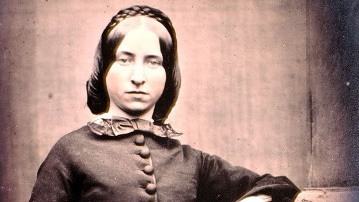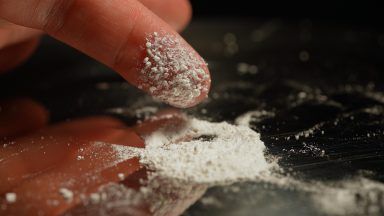On March 23, 1857, the death by poisoning of a Frenchman in Glasgow sparked the most sensational trial of the century, which was followed around the world.
Socialite Madeleine Smith, 22, was arrested and charged with poisoning her older lover Pierre Emile L’Angelier, allegedly slipping arsenic into his hot drinks after he attempted to blackmail her over their relationship.
The high-profile case unfolded over nine days at the High Court in Edinburgh, with the press and prosecutors laying bare the lurid detail of their secret love affair.
But in a remarkable turn of events, the young woman walked free after a ‘not proven’ verdict was returned.
Jurors heard how Smith tried to end her relations with L’Angelier, a warehouse clerk some ten years her senior, when she was betrothed to a wealthy business associate of her architect father who had better prospects.

L’Angelier, who believed they would one day marry, threatened to expose their affair and publish more than 250 love letters between them.
With her reputation and marriage prospects at stake, it was alleged Smith began lacing her lover’s cups of cocoa or coffee with arsenic.
L’Angelier had told friends he had begun feeling unwell and, on one occasion, suggested Smith may have tried to poison him.
He was found in critical pain in his accommodation by his landlady and, despite medical care, died early the following morning.
Police discovered the letters and, when they also found out the young woman had recently purchased arsenic at a druggists, she was arrested and charged.
Who was Madeleine Smith?
Madeleine was born on March 28, 1835, the first child of five in an upper-middle class family.
Her father, James, was a wealthy architect and her grandfather was David Hamilton, the leading architect whose work can still be seen across Glasgow today.
They lived at 7 Blythswood Square in Glasgow and also had a country property, Rowaleyn, near Helensburgh.
Described as a popular young girl, “affectionate, vivacious, and intelligent”, she led a largely uneventful life other than being sent to Miss Gorton’s London finishing school for young ladies when she was 14.
She returned home to Scotland a few years later and it was there that she first met the man known as Pierre Emile L’Angelier.

Pierre was a warehouse clerk and formerly an apprentice gardener from the Channel Islands who had been seeking an audience with young Madeleine for a while.
She was nearly ten years his junior and much above his station, but he convinced a mutual friend of theirs, a young man named Robert Baird, to arrange a meeting.
They met on Sauchiehall Street for the first time and became instantly attracted to one another, embarking on their two-year affair.
Passion, poison and lovers’ vengeance
The case had all the makings of a 19th-century scandal; it fed the Victorians’ obsession with sex and death – while a pretty, young woman with everything to lose was named as the only suspect.
The trial took place at the High Court in Edinburgh on a wet and dismal Tuesday, on June 30, 1857.
A large crowd had gathered to try and catch a glimpse of her but only a privileged few were allowed into the courtroom.
Reports from the time say she entered the courtroom in a brown silk dress with a black silk cloak, “her step as buoyant and her eyes as bright as if she were entering a box at the opera”.
In her hands were a white cambric handkerchief and a silver-topped smelling-bottle which she never used.
She pled not guilty in a strong, clear voice and the trial began.
Their explicit letters were read out in full, revealing the young woman’s sexual appetite, losing her virginity to L’Angelier and referring to herself as his wife.
It was reported by a prison matron that Smith received hundreds of letters from admirers offering consolation, money and marriage proposals during the course of the proceedings.
The public’s anticipation of the verdict reached fever pitch on day nine at Edinburgh’s High Court.
The judge compelled the jury to “look at things morally” in the absence of clear-cut evidence.

But jurors failed to prove that poison had been administered and that the couple had met on the day L’Angelier ingested arsenic.
Another theory was put forward that a heartbroken Pierre had perhaps administered the arsenic on himself in despair when he realised Madeleine was likely to leave him.
Smith walked free from court and began a new life in London with her family, now ostracised from Scottish society.
She eventually married business manager George Wardle and had two children before, in her late 50s, moving to the US. Around 1916, she married a second time to William A Sheehy and this marriage lasted until his death in 1926.
Smith died in New York two years later aged 93.
More than 150 years on, the controversial case remains one of the most notorious in Scottish history with criminologists still divided over whether or not Smith was framed.
In the words of a Scotsman report from the time, she would be known as “either the most fortunate of criminals or the most unfortunate of women”.
Follow STV News on WhatsApp
Scan the QR code on your mobile device for all the latest news from around the country


 Public domain
Public domain




















